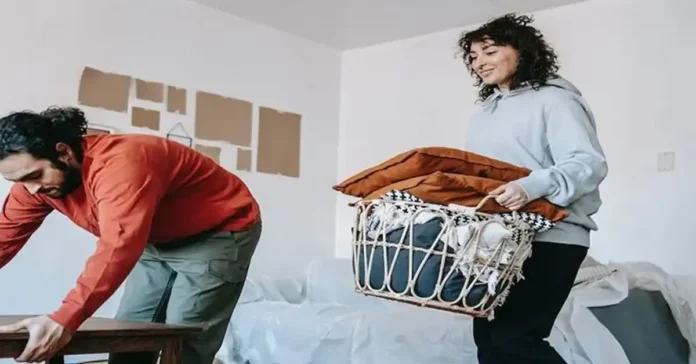A tidy living room can make a huge difference in your home. Whether you’re preparing for guests, amid a renovation, or planning a relocation, decluttering quickly and efficiently is essential. Start by setting a timer for 30 minutes. This creates a sense of urgency and helps you stay focused. Gather all the items that don’t belong in the living room. You can place them in a box or basket for sorting later.
Next, notice surfaces like coffee tables, shelves, and side tables. Remove unnecessary items and only keep what’s essential. Storage solutions like baskets and boxes are used to organize remote controls, magazines, and other small items. Look at your furniture arrangement. Sometimes, moving a few pieces can create more space and make the room feel less cluttered. Consider multifunctional furniture with hidden storage options.
Don’t forget to declutter digital spaces. Organize cables, chargers, and electronic devices. Hide them in a designated box or drawer to keep them out of sight. Finally, add a personal touch. Arrange a few decorative items to give the room a fresh, inviting feel. By following these seven tips, you can transform your living room into a neat, welcoming space in just 30 minutes.
Now, lets understand these method more in depth below.
Declutter Your Living Room
This guide offers practical tips to clear clutter, organize belongings, and create a neat, inviting environment. The guide focuses on easy, actionable steps like sorting items, optimizing storage, and rearranging furniture to maximize space. Whether you’re preparing for guests, in the middle of a renovation, or just want a cleaner space, these strategies will help you achieve a tidy living room in no time. With simple, easy-to-follow advice, you can transform your living room into a more functional area.
1. Consistency
It should not be necessary to declutter every few months. You need to consistently look at your living space from a clutter-free perspective. Build in regular time for decluttering in your schedule. This way, you will not become overburdened and unable to finish things. You will be able to concentrate on just one task at a time instead.
· Keep your House from Becoming a Storage Facility
You must get started right away if you do not want clutter to rule your home. You cannot live life to the fullest in a cluttered environment. You know what needs to be done when you feel like you cannot move forward because there is so much junk all around you – start making some space available.
Start small and rise through the ranks. Decide where you want to put everything before you begin moving things there. Move on to another section after you have enough room cleared. Continue doing this throughout the entire house until the decluttering process is complete.
· Regular Decluttering Keeps Everything Organised
Consistent decluttering helps you develop a system that works effectively for you. You will be able to see what needs to be done and how long each job takes if you keep your living space organised. This makes deciding whether to continue working on a certain item simpler.
Although it may seem like it, decluttering does not take a lot of time. Dedicating 30 minutes a week to decluttering is simple. Even a timer can be used to help you stay on track.
2. Set decluttering goals
Consider your reasons for wanting to get rid of things before you start to declutter. Is it because you have too much on your plate? Would you like to make room for new purchases? Are you attempting to cut costs? Consider how your objectives fit with your present circumstances. For instance, you might decide to sell some of your goods rather than donate them if you are trying to save money. On the other hand, if you are trying to clear up space for new purchases by decluttering, you might want to hold off until you have got a little more money set aside. If you want to purchase a new item, declutter a living space first to create extra space.
Setting decluttering goals is an important part of the decluttering process. Setting goals for decluttering can be done in a variety of ways. To pick what to keep and what to throw away, you might choose to employ one of the following strategies.
· Use a spreadsheet
Create columns for classifications such as apparel, furniture, electronics, etc. Make rows for the things that go in each category. You may, for instance, list apparel items like jeans, shirts, pants, dresses, blouses, coats, jackets, shoes, socks, underwear, tights, jewellery, watches, bags, purses, wallets, umbrellas, etc.
· Maintain a journal
Include what you have achieved and what you plan to do for decluttering.
· Request commentary
Ask everyone you know whether they noticed anything missing or extra once you have accomplished your decluttering. Add anything that is mentioned to your list.
3. Declutter as you go about your day
There are numerous approaches to decluttering. You may designate a certain time each week to deal with a particular category of clutter, such as organising your closet or throwing out outdated books. Alternately, you might just begin small and progress to bigger projects.
· Start Small
Start out slowly if you want to start decluttering. Get organised by focusing on a single room or region of your house. This could entail organising your kitchen cabinets or allotting a specific amount of time each day to clean. Once a routine has been formed, go on to another area. Consider breaking up your task into smaller portions throughout the day if you find that you are having problems keeping to your timetable. For instance, you might spend 10 minutes per day searching your bedroom closet for a certain item while spending 20 minutes per day putting the laundry away. Before declutter a living space, divide them into parts and declutter them one by one.
· Be Realistic
Do not let the need for perfection stop you. Perfect decluttering is impossible to achieve. Instead, concentrate on moving closer to your objective. If you decide to disassemble something, put it back together once more afterwards. Keep your clothing contribution in mind for future donations if you choose to do so. And keep in mind that perfection is an impossibility; just keep progressing.
· Carry out a walkthrough
Look around your home to check if anything is left. Does it seem cluttered? Is the clutter out of control? If so, tidy up a bit.
4. Be ruthless to Declutter Your Living Room
Most of us associate decluttering with getting rid of old clothes and books. There are a lot of other things that we often hold on to even if we know we will not ever utilise them.
Try your closet first. It is likely that if you have not worn something since high school, it no longer fits or is out of fashion. In either case, it is time to part ways.
If you work from home, you are aware of how crucial it is to maintain order in your workspace. Have you ever thought about how much clutter there is in your office? You have a ton of folders, binders, and stacks of paper that you might easily discard.
5. Stay Focused to Declutter Your Living Room
Getting rid of clutter takes time. Expecting to thoroughly clean every inch of your home in a single session is unrealistic. Throughout the procedure, be careful to keep note of what you are doing. This will assist you in maintaining attention and minimising distractions.
· Walk Away
There is no better piece of advice to follow while trying to declutter your house than to “go away.” Those things you have been wanting to throw out forever, right? Put them elsewhere, in a literal sense.
The concept behind a ‘walk away clutter’ is straightforward: Chances are, if you have not used something in a while, you will not use it again. Why hold on to it then? Experts say that organising your space is more important than getting rid of clutter. And moving everything into another room is one of the finest ways to accomplish that. Declutter a living space and move the extra item to another room.
The “maybe box” enters the scene at this point. A Maybe-box is a storage space for items you might want to preserve but you are not sure you will ever need again. You might, for instance, have some old magazines you never read or clothing you purchased ten years ago that still fits you nicely. Put these items in a box as opposed to allowing them to accumulate in your closet. Then, every so often, go through the box and consider if you need everything in there. Fantastic if the response is yes! Maintain it in your home.
7. Stop the Inflow of New Stuff
Finally, keep in mind that occasionally taking a break from something might let you realise just how much we need it. Put off buying anything you do not need for a day or two if you find yourself considering it. You will conclude that you do not actually need it.
When we begin making purchases, it appears as though we are moving closer to our objectives. But over time, we find that we start to gather more things. When we purchase something because we believe we need it but later find out we do not actually utilise it, we feel bad about wasting our money. As a result, we keep making purchases. This cycle keeps repeating itself until we are completely overtaken by the clutter and unable to carry out our daily tasks. While declutter a living space, you find a lot of items that you purchased but have not used them. Store that item in self storage instead of throwing it.
Final Words on Declutter Your Living Room
In conclusion, decluttering your living room can transform it into a more organized and inviting space. By following simple steps like sorting items, using smart storage solutions, and rearranging furniture, you can quickly reduce clutter and enhance the room’s functionality. Regularly maintaining this tidiness will ensure your living room remains a comfortable and welcoming environment for you and your guests. Remember, a decluttered living room not only looks better but also feels more relaxing. Take these easy steps to enjoy a cleaner, more enjoyable living space.
FAQs for Declutter Your Living Room
A: Decluttering the living room creates a more comfortable and inviting space. It reduces stress and improves the overall ambiance.
A: Begin by sorting items into categories: keep, donate, and discard. Focus on one section at a time to avoid feeling overwhelmed.
A: Store rarely used items in labeled boxes and place them in a closet or storage unit. This keeps them out of sight but accessible when needed.
A: Regularly tidy up and return items to their designated spots. Implement a “one in, one out” rule to prevent new clutter.
A: Use multifunctional furniture like ottomans with storage, shelves, and baskets. These help organize items while enhancing the room’s décor.
A: Use cable organizers or clips to keep cords neat and hidden. Consider wireless devices to reduce the number of cables.
A: Keep decorations that you love and that complement your space. Rotate seasonal items to keep the decor fresh and uncluttered.
A: Spend 10-15 minutes each day tidying up. Return items to their places immediately after use to avoid buildup.
A: Assign specific areas or tasks to each family member. Make decluttering a fun activity by setting goals and rewards.
A: Limit sentimental items to a few cherished pieces. Store the rest in a memory box or digitalize them to save space.







